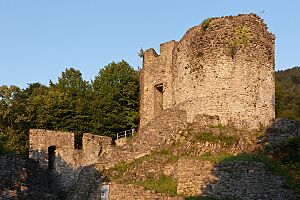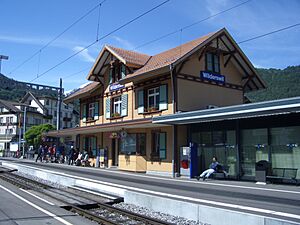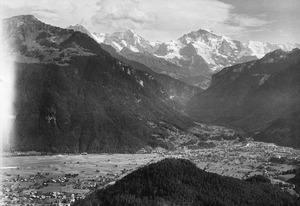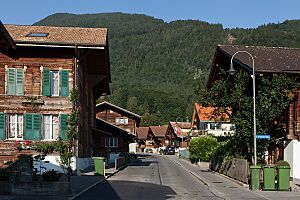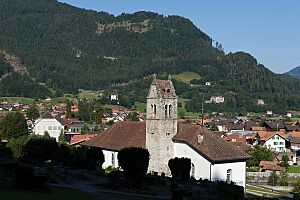Wilderswil facts for kids
Quick facts for kids
Wilderswil
|
||
|---|---|---|
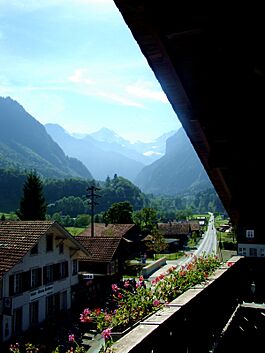
The valley of the Lütschine river, seen from Wilderswil
|
||
|
||
| Country | Switzerland | |
| Canton | Bern | |
| District | Interlaken-Oberhasli | |
| Area | ||
| • Total | 13.19 km2 (5.09 sq mi) | |
| Elevation | 586 m (1,923 ft) | |
| Population
(Dec 2020 )
|
||
| • Total | 2,638 | |
| • Density | 200.00/km2 (518.00/sq mi) | |
| Postal code |
3812
|
|
| Surrounded by | Bönigen, Därligen, Gsteigwiler, Gündlischwand, Lauterbrunnen, Matten bei Interlaken, Saxeten | |
Wilderswil is a charming village and a municipality in Switzerland. It's located in the Bern canton, within the Interlaken-Oberhasli district.
Wilderswil is part of the wider Interlaken area, which has about 23,300 people.
Contents
Exploring Wilderswil's Geography
Wilderswil village sits at the southern edge of the Bödeli. The Bödeli is a piece of land between Lake Thun and Lake Brienz in the Bernese Oberland region. It's found at the start of mountain valleys where the Lütschine river flows. The Saxetenbach river, a smaller stream, also joins here. Wilderswil is about 4 kilometers (2.5 miles) south of Interlaken, the main town in the Bödeli area.
The municipality stretches for about 8 kilometers (5 miles) from the village. It follows the west bank of the Lütschine river. It also includes the sides of the mountains that border the valley to the west. The land here ranges from about 580 meters (1,900 feet) high on the Bödeli plain. It goes up to 2,413 meters (7,917 feet) at the top of Sulegg mountain. Wilderswil includes the smaller villages of Mülenen and Gsteigallmend.
Wilderswil covers an area of 13.5 square kilometers (5.2 square miles). About 19.7% of this land is used for farming. Forests cover a large part, 57.4% of the area. Around 10% of the land has buildings or roads. Rivers and lakes make up 1.3%, and 11.6% is unproductive land, like rocky areas.
A Look at Wilderswil's History
The area where Wilderswil is located was settled by a group of people called the Alamanni around the year 600. The name "Wilderswil" comes from this time. In 1895, during digging for a new hotel, a graveyard from the 7th century was found. It had 15 graves with 18 skeletons and old objects buried with them.
Wilderswil was first mentioned in official records in 1224. Unspunnen Castle, which is in the municipality, was first mentioned in 1232.
Wilderswil was once ruled by powerful families called barons. Later, the villages of Mülenen and Grenchen were part of a territory called a Herrschaft (a type of lordship) belonging to Weissenau Castle. Around 1334, the lord of Weissenau joined other nobles in a war against the growing city of Bern. After they lost, Weissenau had to sell his castle and land to Interlaken Monastery to pay his debts.
In 1528, Bern adopted the Protestant Reformation, a new Christian faith. They started to introduce it in the Bernese Oberland. The monastery and its villages, including Mülenen and Grenchen, tried to fight against this new faith but were unsuccessful. After Bern took control, they took over the monastery's lands. These two villages then became part of Bern's bailiwick (an area governed by a bailiff) of Interlaken. In the 15th century, the mountain village of Gsteigallmend was built. Over the next century, Grenchen was slowly abandoned.
Wilderswil village itself was part of the Herrschaft of Unspunnen. It stayed under Unspunnen's rule until the late 15th century. Between 1488 and 1515, the city of Bern slowly gained control of Unspunnen. By 1798, Wilderswil became part of the municipality of Unterseen.
Since 1805, a special festival called the Unspunnenfest has been held regularly near the ruins of Unspunnen Castle. This festival celebrates traditional Swiss culture.
Tourism started to grow in Wilderswil in the 19th century. This happened after a road was built from Interlaken to the Lütschine river valleys. The Bernese Oberland Railway opened a station in Wilderswil in 1890. Two years later, a base station for a funicular railway (a mountain train) to the Schynige Platte was built. These easy transport links led to many hotels and resorts being built. By 1910, there were twelve hotels in the municipality.
The tourism industry faced challenges during the World Wars and the Great Depression. However, in 1941, the Swiss Army built an airfield in Wilderswil. The airfield and the railway became the biggest employers. The airfield closed in 2003. As of 2014, it is used for racing and concerts.
Wilderswil's Coat of Arms
The blazon (description) of Wilderswil's municipal coat of arms is: Per bend sinister Argent and Sable overall a Buck counterchanged. This means it has a diagonal line from top right to bottom left. One side is silver (Argent), and the other is black (Sable). On top of this, there is a buck (a male deer) that is half silver and half black, with the colors swapped on each side.
People and Population
Wilderswil has a population of about 2,500 people. As of 2010, about 10% of the people living there were foreign nationals. Between 2000 and 2010, the population grew by 12.7%. Most of this growth came from people moving into the area.
Most people in Wilderswil (about 94.5%) speak German as their main language. Serbo-Croatian and Italian are the next most common languages.
In 2008, the population was almost evenly split between males (49.8%) and females (50.2%). About 29.8% of the people living in Wilderswil in 2000 were born there. Many others were born in the same canton (43.3%) or elsewhere in Switzerland (13.3%). About 10.5% were born outside Switzerland.
In 2010, children and teenagers (0–19 years old) made up 21% of the population. Adults (20–64 years old) made up 61.5%, and seniors (over 64 years old) made up 17.6%.
The chart below shows how the population of Wilderswil has changed over time:

Important Sights
The main village area of Wilderswil is recognized as an Inventory of Swiss Heritage Sites. This means it's a special place with important historical and cultural value. The village of Gsteig bei Interlaken, which is partly in Wilderswil, is also part of this list.
Wilderswil's Economy
In 2011, Wilderswil had a low unemployment rate of 1.57%. In 2008, there were 989 people working in the municipality.
- About 43 people worked in the primary sector, like farming.
- 380 people worked in the secondary sector, which includes manufacturing and construction.
- 566 people worked in the tertiary sector, which covers services like hotels, shops, and education.
Many people who live in Wilderswil travel to other places for work. In 2000, 811 people left the municipality for work, while 300 came in. This means more people leave Wilderswil to work than come in. About 16.9% of workers used public transportation, and 46.4% used a private car.
Religion in Wilderswil
All three villages that make up Wilderswil belong to the large parish (church district) of Gsteigwiler.
According to the 2000 census:
- About 11.9% of the population were Roman Catholic.
- About 73.4% belonged to the Swiss Reformed Church (a Protestant church).
- Smaller numbers of people belonged to other Christian churches, including Orthodox and Christian Catholic.
- About 1.7% of the population were Muslims.
- There were also a few Buddhists and Hindus.
- About 6.6% of the people said they had no religion or were agnostic or atheist.
Education for Kids
In Wilderswil, many people have completed higher education. About 44.6% of the population finished non-mandatory upper secondary education. About 8.9% went on to complete university or a specialized college.
The school system in the canton of Bern starts with one year of optional Kindergarten. After that, there are six years of primary school. Then, students go to three years of lower secondary school. In lower secondary, students are grouped based on their abilities. After this, students can continue their education or start an apprenticeship (on-the-job training).
During the 2010–2011 school year, 322 students attended schools in Wilderswil.
- There were two kindergarten classes with 26 students.
- There were nine primary classes with 183 students.
- There were five lower secondary classes with 97 students.
A small number of students in each group were not Swiss citizens or spoke a different language at home. Some students also attended private or special schools.
In 2000, 113 students came to Wilderswil for school from other municipalities. At the same time, 69 residents of Wilderswil went to schools outside the municipality.
Getting Around Wilderswil
Wilderswil railway station is the main transport hub in the town. Berner Oberland Bahn trains pass through here, connecting Interlaken with places like Lauterbrunnen and Grindelwald. The station is also the starting point for the Schynige Platte Railway, which takes you up the mountain.
Wilderswil also has good road access to the A8 motorway. In August 2023, a new 2-kilometer (1.2-mile) bypass road was finished. This road helps reduce traffic in Wilderswil. The new road system also includes links to the old airfield. It has a tunnel that can be used to drain water if the Lütschine River floods badly. This project cost 70 million Swiss francs.
Tourism in Wilderswil
Wilderswil is a great starting point for trips into the Jungfrau region because of its location. The town has 16 hotels and motels with about 900 guest beds. There are also 300 vacation homes and one camping site that is open in the summer.
Famous People from Wilderswil
- Urs Räber, a skier
- Eugenie Schumann, a pianist and the daughter of the famous composer Robert Schumann and pianist Clara Wieck Schumann
Images for kids
See also
 In Spanish: Wilderswil para niños
In Spanish: Wilderswil para niños






